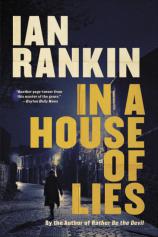In a House of Lies
Review
In a House of Lies
It is always nice to see John Rebus back. Author Ian Rankin has been aging Rebus along since introducing him in the landmark novel KNOTS AND CROSSES over three decades ago. That book and the subsequent installments in the series have formed the foundation for the mystery subgenre that has become known as “tartan noir” while also providing a look at how the job of police procedure is done in and around Edinburgh, Scotland. IN A HOUSE OF LIES, the latest entry, finds Rebus haunted by his past and confronted in his present, even as he contemplates his dwindling future, all to sobering but excellent effect.
The “house of lies” of the title has a double meaning that echoes throughout the book. Rebus, once Detective Inspector Rebus, is now a pensioner who finds it somewhat difficult to manage the stairs to his second story flat and even more difficult admitting to it. His mind, though, is still sharp, and he is fully capable of managing the occasional horizontal bop with proper inspiration and pacing, in that order. However, what is giving Rebus the most headaches these days are his professional sins, errors and omissions of the past, which, as readers of this superlative, long-running series will recall, are significant, no matter how ultimately well-intended.
"IN A HOUSE OF LIES...finds Rebus haunted by his past and confronted in his present, even as he contemplates his dwindling future, all to sobering but excellent effect."
IN A HOUSE OF LIES kicks off with the discovery of an abandoned automobile in the woods near a rambling estate that is slowly falling to ruin. The car contains the body of Stuart Bloom, a private investigator who has been missing for several years; according to forensics, that is how long the involuntary passenger has been dearly departed. The problem (among others) is that the initial disappearance had been investigated by Rebus and his colleagues at the time, and a hindsight review of their work concludes that it appears to have been sloppy at best and perhaps deliberately negligent at worst. An additional noteworthy element is that Bloom was handcuffed at the time of his death with what looks to be police regulation manacles.
DI Siobhan Clarke, who is Rebus’ straight-arrow heir apparent on the force, is interested in protecting her mentor to the extent possible, even as she has no particular problem getting into trouble on her own account. Rebus, though, has left a couple of powerful enemies behind him on the Scotland police force who would not mind seeing him walk the plank of accountability right up to pension forfeiture and prison. What no one --- well, hardly anyone --- wants is for Rebus to be hanging around the investigation, but that is exactly what he does, using his knowledge of what had gone before in conjunction with modern forensics and his still-sharp powers of observation and intuition to figure out what is going on.
It’s a bit of a complex thicket as the suspects seem to narrow to a couple of old enemies who, after decades, continue to have it in for each other and are quick to pin the blame on the other. Naturally, one of them is wrong. Maybe. Rebus sorts things out by story’s end and even manages to identify the real killer in an unrelated closed case. As is obvious from the novel, retirement suits Rebus well. Unofficially, of course.
IN A HOUSE OF LIES is a bit more cerebral than the other installments in the extended Rebus canon, though it is still interesting nonetheless. One would not expect Rebus, while experiencing the limitations of chronic obstructive pulmonary disease and advanced age, to be kicking posterior at the drop of a hat, but the man can still take names. Rankin is obviously sending Rebus ever so slowly and gently into that good night, even as he passes the story baton to Clarke. Still, if IN A HOUSE OF LIES is any indication, Rebus won’t be leaving us anytime soon.
Reviewed by Joe Hartlaub on January 4, 2019




